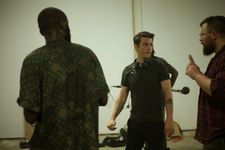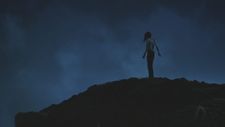 |
| The view across Withren |
In part one of my interview with Nicholas Ashe Bateman we discussed the genesis of The Wanting Mare and the fantasy world of Anmaere where it’s set, along with the challenges of getting this production – made almost entirely in one warehouse with computer-generated sets – off the ground. Subsequently I mentioned Sky Captain And The World Of Tomorrow and the impression that made when it came out in 2004. Why hasn’t that technology been used more since? Does it simply require too much time and effort for most people to be willing to take it on?
“I think that is the question,” he says. “It is possible and I think it’s ubiquity depends on how much time needs to be spent on it. “However, this great promise of a digital future is something that has ignited my imagination since I was a kid, when I heard Peter Jackson talking about trying to start WETA Digital when they had three computers, and he was just ecstatic in the special features about how this was a possibility. I was a little kid watching it and I was like ‘They’re doing it – I guess I can do it! I guess I need to go buy a computer.’
 |
| Edmond Cofie, Nicholas Ashe Bateman and David A Ross at work Photo: Alex Shi |
“I saw Gareth Edwards’ Monsters in 2010 and that was pretty close to the point when I realised ‘Okay, if you’re ever going to get to make this movie it’s going to have digital effects, whether you like it or not. These places don’t exist. No-one’s ever going to give you this money. You probably need to figure out how to do this. At each point – one was ten years ago, the other about 20 years ago – each one was sot of saying ‘It’s all coming now.’ However, I think that is true. I think this is going to happen more and more and more.
“My excitement with the film is that, you know, previously when people made a visual effects movie it was usually to show off visual effects. if I had an endless amount of money I could not make spaceships land over a city. My budget has nothing to do with it. it requires visual effects.
“I’m an avid Tarkovsky lover. I think he’s the great artist. You know the story of him with the helicopter? that’s visual effects. He’s doing the same thing, in Mirror. He’s writing something and he says ‘I want the grass to blow’ – you think of that grass blowing and these people awash in memories and time – ‘so we’ve got to get a helicopter.’ A helicopter is just a big piece of machinery, it’s so dissimilar from how we think about these images. If you imagine how they filmed it, before they replaced the audio you probably couldn’t hear anything. It was probably this big ugly mess, and that’s just an incredible thing to me. Of course we look at these things through a veil of nostalgia and say ‘What a wonderful thing, how people used to make movies’ – but everybody is hopefully doing the same. So for me, I’m doing visual effects to make grass ripple, to have wind and water and those things, so that I do think is an exciting step.
“If I’d tried to make this exact movie starting seven years ago, I couldn’t have done it. If I started to make this movie today, right now, from the beginning, it would take half the time. I burned through six computers on programs that, if I were to do the same effect now, I could do it in a day. The speed at which these things are increasing is incredible and exciting to me.”
I interject to say that, from my perspective, it’s the quality of the practical work is essential to making these effects work as well as they do in The Wanting Mare. The lighting, in particular, creates a seamless connection between the actors and their surroundings.
“I think it’s because of the separation of labour,” says Nicholas. “David A Ross, for example, who is the director of photography, and Zach Schaefer who is the gaffer, they’re there the entire time. They’ve been there for years. They were there in the office afterwards. So they’re not showing up on the day with a call sheet and saying ‘Oh, they’re shooting on green screen today. We don’t really have to light. We’ll give them flat lighting,’ and then a visual effects supervisor comes in and says ‘Well, we’re not sure what the matte painting’s going to be,’ and then the matte painters are compositing based on the way the light was and everyone’s try to react to each other.
 |
| Wild horses run along the Withren coast |
"In this instance it was different. I love to show off the scenes in the driveway at the end. There’s flares, you can see the light from the headlights of the car on him [Josh Clark] to a point where it’s very strong and it’s almost underexposed on the other side. David is making exposure choices for a background that doesn’t exist and then he’s having a layer of creativity on top of that, and saying ‘Well, I don’t think I would have been able to light the driveway that well.’ That is an incredibly exciting thing to me.
“I know how David shoots things and I know what his interests are so I’m able to composite the shot in the style of David, and it’s just a joy.”
He intends to carry on working with the same people as much as possible, he says. “We’re talking about the thing that we want to make next, as soon as we can – when the world begins again. There are parts of it which are exciting to us because we would have never thought, a year ago, that we’d be doing something like that. We’re now starting to plan. We might be able to get to do more things practically.
“Additionally, as well as the practical stuff, there’s Cassandra Louise Baker and Duncan Bindbeutel, production designer and art director. Cassandra was the production designer on the first stage when the extent of the production design was, like, some set dressing. However, her overall effect and influence was moving up toward the Andrew Wyeth sort of thing. And then of course when we got a little more money for the second half we got to build these primary sets – they got to make all those things. They then got to light those and the whole thing just started to grow.
“Honestly I feel that if this movie is successful I don’t think the movie is good because we captured some sense of having too little resources. I sometimes worry that it’s the opposite, where someone watches the film and they think that we had a lot more choice than we do.” He laughs. “The analogy I always use is the Blade Runner bazaar. it’s this great feat of world building where someone has to go shopping and so you see all this mash of cultures. I would love to do those things but the most people I was ever able to get on one day was, like, five people! People are like ‘I love this fantasy and I want to see more of the world,’ but I’m like, ‘Well, I barely have these two people on this driveway.’
“I think it’s exciting to all of us to start building out an actual world. I segmented Withren [the city where most of the film is set] in my mind on the western side of the world and then I have another continent which is referenced in film which is more of a traditional Middle Earth or Westeros sort of thing, where there’s influence within cultures and there’s economics and society.”
 |
| Close to the edge |
I suggest that he seems to be trying to do something a bit different with his fantasy world and not stick too closely to those kinds of established ideas.
“I am. I’m trying,” he says. “I deeply believe that Tolkien is one of the most important artists we have ever had, and I’m concerned that the wizards and elves are clouding this incredible thing that this person wished to do. I’m looking at it from a pretty secular point of view – I don’t know if that’s necessarily how he was looking at it – but I think there is an interest in people, and the point, for me, of his fantasy, is not fetishising the Medieval time. I think it is trying to imbue us now with a greater possibility. I’m trying to be in conversation with that profound mass of idea in the film.
“The dramatic conflict of the film is basically a rhetorical discussion about the importance of an idea. If a time of myth and magic actually existed, what does that mean? How does that change us? When these two people are young and they’re not in love and they haven’t lost each other, they haven’t experienced all these immutable things of living, myth and magic have no use. When they get older and they have, it would be very wonderful to shift the pieces around.
“With Tolkien, I think he’s saying that we have come from something wonderful and great, and he’s filling that period of time with what is wonderful and great. For me, there’s nothing more to do there. I can try, but never in a lifetime would I be able to do a quarter of what this person has made. So my interest is how that ages. I want to continue that idea and if there’s an overall thrust, if I get to keep making these things in this world, to say ‘What is the causation between these things?’ Then, in a larger sense, I get to talk about time again. How do we begin? Because I don’t know how we begin. It’s one of our great questions.
“I like the idea of hiding that somewhere far away in whatever I’m making, and slowly making my way back. Maybe someone will have chain mail at some point!” He laughs. “I can’t promise dragons but maybe chain mail.”
We talk about the Chattanooga Film Festival – online this year – where the film had its première, and the weirdness of it opening in this situation.
“I’ve never seen the film in a theatre,” he says. “I’ve never seen it projected on a sound stage or anything like that.” He points to the machine besides him. “I’ve seen it on this computer – this current one that I haven’t ruined – and on a TV, at 60 inches. But obviously we’re dreaming about what would this thing look like if we could see it in a theatre? We made it that way, but at the same time it almost makes more sense that what we made here [on a computer] will probably be watched there. I’m terribly excited about people getting to see it, obviously.”
The Wanting Mare will be available to rent or own on digital HD on 7 February 2022.





















